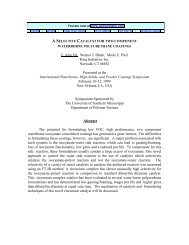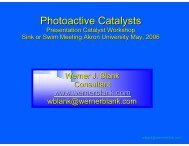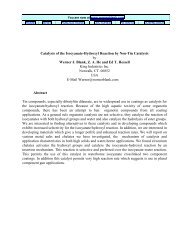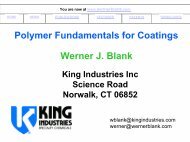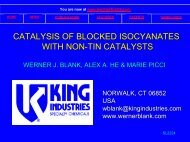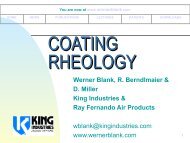Catalysis of the Epoxy-Carboxyl Reaction - Werner Blank
Catalysis of the Epoxy-Carboxyl Reaction - Werner Blank
Catalysis of the Epoxy-Carboxyl Reaction - Werner Blank
You also want an ePaper? Increase the reach of your titles
YUMPU automatically turns print PDFs into web optimized ePapers that Google loves.
ate is determined by <strong>the</strong> decomposition <strong>of</strong> <strong>the</strong> acid salt formed between <strong>the</strong> carboxyl<br />
group and <strong>the</strong> basic catalyst 8 .<br />
R'<br />
R'<br />
R'<br />
O<br />
O<br />
O<br />
OH<br />
O<br />
O<br />
R<br />
+ B ↔<br />
+<br />
O<br />
O<br />
R<br />
R<br />
O<br />
R'<br />
paper23.doc Printed 4/20/2003<br />
R'<br />
O<br />
O<br />
O<br />
+ R'<br />
O<br />
B<br />
O<br />
O<br />
R<br />
↔ R'<br />
OH → R'<br />
O<br />
→ R'<br />
O<br />
O<br />
O<br />
O<br />
R<br />
O<br />
+ BH ⊕ (5)<br />
R<br />
O<br />
R<br />
O<br />
OH<br />
R<br />
O<br />
+ R'<br />
O<br />
(6)<br />
O (7)<br />
The catalytic activity <strong>of</strong> different bases 9 was found to decrease in <strong>the</strong> following<br />
order: pyridine 10 > isoquinoline > quinoline > N,N-dimethylcyclohexylamine ><br />
tributylamine > N-ethylmorpholine > dimethylaniline > potassium hydroxide. This order<br />
<strong>of</strong> reaction would be different if <strong>the</strong>se compounds are used as curing catalysts for<br />
coatings, due to <strong>the</strong> evaporation in thin films. A tertiary amine catalyst can also be<br />
incorporated as an internal catalyst into acrylic polymers and this approach is <strong>of</strong>ten taken<br />
for can coatings.<br />
Quaternary ammonium and phosphonium compounds were found to be excellent<br />
room temperature catalysts for automotive refinishing 11 .<br />
In recent work <strong>the</strong> catalyzed reaction <strong>of</strong> water dispersed polymers having tertiary<br />
amine functionality was studied with glycidyl ester functional emulsions at room<br />
temperature. 12 The actual mechanism <strong>of</strong> crosslinking was not <strong>the</strong> reaction <strong>of</strong> <strong>the</strong> epoxy<br />
groups with <strong>the</strong> carboxyl groups, but ra<strong>the</strong>r <strong>the</strong> formation <strong>of</strong> quaternary ammonium<br />
groups and subsequent salt formation <strong>of</strong> <strong>the</strong> quaternary ammonium groups with <strong>the</strong><br />
carboxyl groups. (Eq.8)<br />
R' R'<br />
NH<br />
R'<br />
O<br />
O<br />
R"<br />
+ O<br />
R' → R' R<br />
N<br />
R' R' OH<br />
Imidazoles have been found to be very effective catalysts for <strong>the</strong> epoxy-carboxyl<br />
reaction 13 . A variety <strong>of</strong> imidazoles with different substitutions and pKa values are<br />
commercially available. Imidazoles were found to show superior catalysis to<br />
dicyandiamide in powder coatings 14 .<br />
Ano<strong>the</strong>r potential mechanism, which has been suggested with amine catalysts, is<br />
<strong>the</strong> activation <strong>of</strong> <strong>the</strong> e<strong>the</strong>r linkage as shown in <strong>the</strong> reaction schema below (Eqs.9,10,11,<br />
12, 13 and 14)<br />
O<br />
O<br />
R"<br />
(8)



